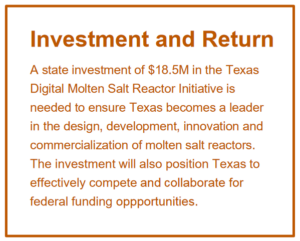Next Generation Energy
Nuclear energy is the leading candidate to supplement fossil fuels as an energy source and molten salt reactors
(MSR) offer a new path to employing this resource that traditional reactor designs cannot. Molten salt reactors
offer significant advantages in safety, sustainability, energy security and waste management. The most
catastrophic accident at a traditional commercial nuclear reactor, which operates with high-pressure water using
solid fuel, is a rapid depressurization and melting of fuel. MSRs operate at atmospheric pressure with liquid fuel
and are inherently safer than today’s reactors. The Nuclear Regulatory Commission (NRC) requires massive
amounts of data to evaluate the safety of any individual design change, and the generation of that data can take
decades. The creation of verifiable tools would allow safe design progress so that the molten salt reactor’s
capabilities will not be limited by a single design that never changes or can be commercialized.
Texas Solution
There is currently a major push by both industry and academia in Texas to commercialize MSRs. This includes a
university research reactor at Abilene Christian University (ACU), which is currently in progress, followed by
another research reactor and commercial reactors in quick succession at other sites throughout Texas.
The Digital Molten Salt Reactor Initiative proposes to:
- Build a digital twin reactor to generate massive amounts
of data to improve the accuracy of digital modeling. - Design an extensive set of sensors and simulation
tools to track everything that happens in the MSR
that is being built at ACU to demonstrate that we can
predict how MSRs perform to justify design
improvements in future reactors to the NRC.
- Establish digital twin models for
experimental salt corrosion and chemistry to
better understand the impact on MSRs. - Build a digital model of the electric grid to
test and demonstrate the value of MSRs for
improved reliability and resilience in the
electric supply.
The digital molten salt reactor initiative will allow the industry to practice the kind of continuous innovation that has made the U.S. a leader in other industries, like computer science and commercial aviation.
Why UT Austin?
UT will leverage and expand existing infrastructure,
research capabilities, world-class talent and
degree programs.
- Texas Advanced Computing Center – the world
leader in university high-performance computing. - Oden Institute – high-fidelity computational science
and engineering - Energy Institute – leading research on the
energy economy - NETL Reactor – newest research reactor
in the U.S.

Goals and Objectives
Mission
- Demonstrate practical application of digital twins (DTs) for nuclear/molten salt systems to understand and communicate a vision for how DTs will be used for enabling licensing of technological advances in advanced reactors.
Vision
- Establish UT as the leading university for R&D of DTs for advanced reactors, with an initial focus on molten salt fueled reactors
Goals
- Deliver technical success in the use of complete DTs for at least two (of four) systems.
- Elevate nuclear at UT to be a premier university for computational nuclear energy, as measured by quality of applicants and new research partnerships.
- Acquire and maintain at least $3M/year funding for nuclear energy R&D.
- Commercialize at least one DT developed (at least partially) through State of Texas funding.
